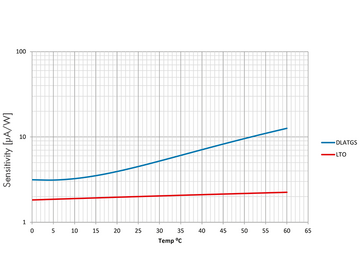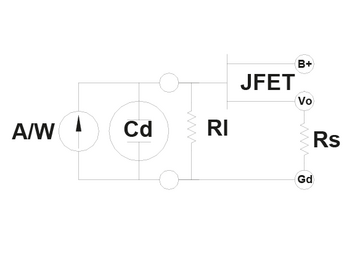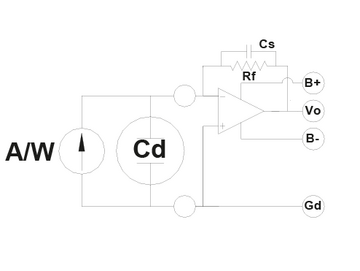Pyroelectric detectors are thermal detectors: Temperature fluctuations produce a charge change on the surface of pyroelectric crystals, which produces a corresponding electrical signal. This temperature gradient can be created by the absorption of light.
There are different pyroelectric materials available, three of which are commonly used in pyroelectric detectors: DLaTGS, LiTaO3, and PZT.
The table provides an overview of the materials’ properties. Simply put, the figures mean the following:
- The pyroelectric coefficient determines the ability to produce current from IR radiation. That is to say: the bigger, the better.
- The dielectricity constant determines the capacitance, thereby affecting the noise. In voltage operation, the following is true: The larger the capacitance, the lower the noise.
The dielectricity constant corresponds in the exact opposite manner. - The specific heat capacity determines the temperature increase in the crystal depending on the absorbed radiation. A low Cv means a larger temperature increase and thus a better signal.
- The specific AC resistance is coupled with dielectric losses that, in turn, produce a kind of Johnson noise. A pure dielectric would not produce any noise. The lower the AC resistant, the better.
To compare materials with regard to their fundamental suitability for pyroelectric detectors, it makes sense to analyze them using the parameter pyroelectric coefficient specific AC resistance/dielectric constant specific heat capacity. DLaTGS and LiTaO3 achieve the best results; thus, they are particularly well suited.
DLaTGS is the material with the highest performance level (approx. 2x109 @ 10 Hz). The use of this material is widespread in IR measurement technology in the laboratory, especially in routine FTIR applications. Industrial applications are largely reserved for LiTaO3 due to its thermal behavior (s. Fig. 1). PZT is primarily used in consumer products.
The Modes of Operation of Pyros
The IR crystal is modulated as a power source with a parallel capacitance and housed in a TO can with additional electronic components. There are two basic modes of operation of pyro detectors: voltage mode (VM) (Fig. 2) and current mode (CM) (Fig. 3).
Voltage mode (VM): JFET-based voltage mode has been widely used for a long time; however, it has critical disadvantages and can only be recommended for experienced users: It produces a relatively low signal on a strongly temperature-dependent offset. But this mode of operation also has some advantages: The highest value for D* can be achieved with the simplest design (approx. 0.5x109 @ 10 Hz), and the amplification is flexible.
Current mode (CM): In current mode, a high signal is produced on a low offset with relatively low temperature dependence. For current mode, OPVs are required that exhibit just a low electrical power consumption. With this version, beginners can most quickly and successfully develop their product. The low output impedance leads to additional EMC advantages.
D* achieves similar values to voltage mode with a slightly more complex design: A second blind detector element that is connected in an antiparallel manner is required for this purpose. For this configuration, the somewhat ambiguous term “temperature compensation” (TC) has become prevalent. This blind element attenuates undesired signals resulting from fluctuations in the surrounding temperature, but it does not compensate for physically predefined temperature dependencies, such as those shown in Fig. 1. Thus, it is more a signal stabilization or “temperature fluctuation compensation” (TFC).
TFC increases the performance level in current mode; however, in voltage mode it is reduced by half. This is caused by the fact that in current mode TFC attenuates the tendency toward natural oscillation, thus allowing a larger amplification.
LASER COMPONENTS’ Product Range
The LASER COMPONENTS Pyro Group manufactures both DLaTGS and LiTaO3-based pyro detectors. All commercially-available options – from multicolor to miniaturized versions to detectors with a reduced microphonic effect – are represented and successively refined as the portfolio grows.
More detailed information is available from our product engineers.

Good to Know
Detectivity D*
D* represents the signal-to-noise ratio for a certain electrical frequency and bandwidth if 1 watt of radiation power reaches a detector surface of 1 cm2. The higher the D* value is, the better the detector is.![]()









